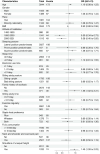Evaluation of the prevalence of adolescent scoliosis and its associated factors in Gansu Province, China: a cross-sectional study
- PMID: 39139664
- PMCID: PMC11319255
- DOI: 10.3389/fpubh.2024.1381773
Evaluation of the prevalence of adolescent scoliosis and its associated factors in Gansu Province, China: a cross-sectional study
Abstract
Introduction: Gansu Province is situated in the northwest region of China, characterized by diverse and complex topography and a rich diversity of ethnic groups. This study aims to explore the prevalence and risk factors of adolescent suspected scoliosis in Gansu Province through a cross-sectional population study.
Methods: From April 2022 to July 2022, a prospective cross-sectional study was conducted in Baiyin City, Jinchang City, Lanzhou City, Linxia Hui Autonomous Prefecture, and Gannan Tibetan Autonomous Prefecture in Gansu Province. The screening covered 3,118 middle and high school students across 24 institutions, including middle and high schools. Diagnosis of suspected scoliosis was established through visual inspection, the Adams forward bend test, and measurement of trunk rotation angle. Employing a custom-designed questionnaire, demographic data were collected, and the prevalence of suspected scoliosis was calculated. Univariate and multivariate logistic regression analyses were employed to assess factors associated with suspected scoliosis.
Results: A total of 3,044 participants were ultimately included in the analysis. The overall prevalence of suspected scoliosis was 5.68% in Gansu Province. The peak prevalence for boy is at 14 years (6.70%), while for girl, it is at 15 years (8.75%). Lanzhou City exhibits the highest prevalence rates (boy, 9.82%; girl, 10.16). The results of univariate logistic regression analysis presented that BMI (OR = 0.92, 95% CI: 0.88-0.96), altitude of habitation (1,600 m-2000 m) (OR = 0.50, 95% CI: 0.34-0.73), altitude of habitation (2000 m-3321 m) (OR = 0.58, 95% CI: 0.40-0.83), family medical history (OR = 1.56, 95% CI: 1.02-2.31), and shoulders of unequal height (OR = 1.49, 95% CI: 1.09-2.03) were significantly correlated with suspected scoliosis. The multivariate logistic regression analysis indicated that BMI (OR = 0.91, 95% CI: 0.86-0.95), altitude of habitation (1,600 m-2000 m) (OR = 0.35, 95% CI: 0.23-0.54), altitude of habitation (2000 m-3321 m) (OR = 0.39, 95% CI: 0.24-0.60), family medical history (OR = 1.66, 95% CI:1.08-2.49), and shoulders of unequal height (OR = 1.45, 95% CI:1.06-1.99) were independently associated with suspected scoliosis.
Conclusion: Low BMI, residence at an altitude of 1,600 m-3321 m, family medical history, and shoulders of unequal height were independently associated with an increased prevalence of suspected scoliosis. It is recommended to promptly screen high-risk adolescents for suspected scoliosis, provide effective preventive and intervention measures.
Keywords: adolescence; cross-sectional study; prevalence; risk factors; scoliosis.
Copyright © 2024 Huang, Zhang, Wen, Liu, Xu, Wang, Zhang, Wang, Pei, Cui, Wang, Tang and Zhao.
Conflict of interest statement
The authors declare that the research was conducted in the absence of any commercial or financial relationships that could be construed as a potential conflict of interest.
Figures






Similar articles
-
Scoliosis among children in Qinghai-Tibetan Plateau of China: A cross-sectional epidemiological study.Front Public Health. 2022 Aug 19;10:983095. doi: 10.3389/fpubh.2022.983095. eCollection 2022. Front Public Health. 2022. PMID: 36062094 Free PMC article.
-
Regional disparity in epidemiological characteristics of adolescent scoliosis in China: Data from a screening program.Front Public Health. 2022 Dec 6;10:935040. doi: 10.3389/fpubh.2022.935040. eCollection 2022. Front Public Health. 2022. PMID: 36561865 Free PMC article.
-
Prevalence of incorrect posture among school adolescents after the COVID-19 pandemic: a large population-based scoliosis screening in China.J Orthop Surg Res. 2025 Feb 12;20(1):156. doi: 10.1186/s13018-025-05479-8. J Orthop Surg Res. 2025. PMID: 39939858 Free PMC article.
-
Distribution of scoliosis in 2.22 million adolescents in mainland China: A population-wide analysis.J Glob Health. 2024 Jul 19;14:04117. doi: 10.7189/jogh.14.04117. J Glob Health. 2024. PMID: 39026457 Free PMC article.
-
The prevalence of scoliosis among adolescents in China: a systematic review and meta-analysis.J Orthop Surg Res. 2024 Sep 28;19(1):585. doi: 10.1186/s13018-024-05077-0. J Orthop Surg Res. 2024. PMID: 39342221 Free PMC article.
Cited by
-
Epidemiological trends and predictive factors of adolescent scoliosis in qingdao: insights from a Large-scale screening program (2022-2024).Eur Spine J. 2025 Aug 14. doi: 10.1007/s00586-025-09245-6. Online ahead of print. Eur Spine J. 2025. PMID: 40804499
References
-
- Kuznia AL, Hernandez AK, Lee LU. Adolescent idiopathic scoliosis: common questions and answers. Am Fam Physician. (2020) 101:19–23. PMID: - PubMed
-
- Donzelli S, Zaina F, Lusini M, Minnella S, Negrini S. In favour of the definition "adolescents with idiopathic scoliosis": juvenile and adolescent idiopathic scoliosis braced after ten years of age, do not show different end results. SOSORT award winner 2014. Scoliosis. (2014) 9:7. doi: 10.1186/1748-7161-9-7 - DOI - PMC - PubMed
-
- Cárcamo M, Espinoza P, Rodas M, Urrejola Ó, Bettany-Saltikov J, Grivas TB. Prevalence, risk of progression and quality of life assessment in adolescents undergoing school screening for adolescent idopathic scoliosis. Andes Pediatr. (2023) 94:78–85. doi: 10.32641/andespediatr.v94i1.3989 - DOI - PubMed
MeSH terms
LinkOut - more resources
Full Text Sources
Medical
Miscellaneous

